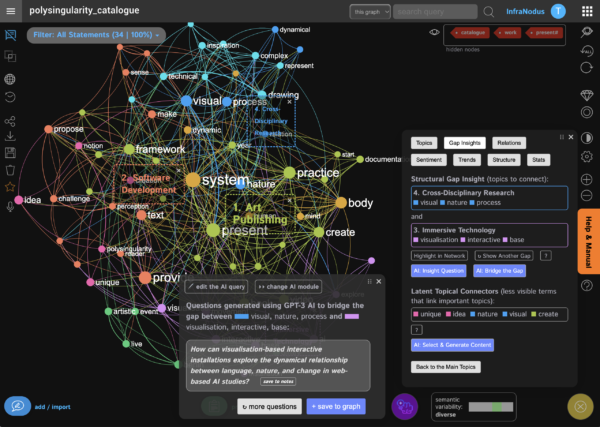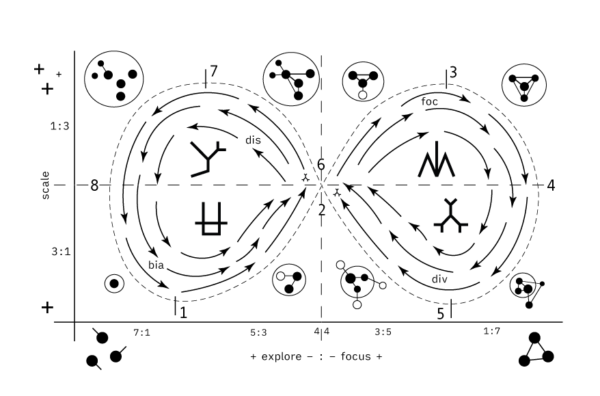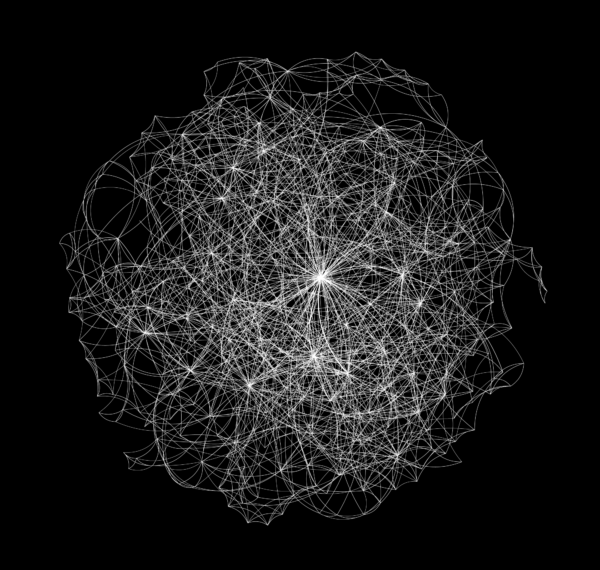InfraNodus is a tool, framework, and methodology for generating ideas and insight with network thinking and AI. It also promotes cognitive variability, which helps make perception and thinking more adaptive and resilient. InfraNodus uses a combination of text network analysis, data visualization, natural language processing, and AI to extract the most important elements of any discourse and to encourage a user to change their perspective and connect their ideas in a new way.
Starting as an artistic research project by Dmitry Paranyushkin in 2012, InfraNodus evolved into a subscription-based online tool that is used by thousands of people and companies worldwide in applications ranging from competitive intelligence and discourse studies to ideation and writing.
Its unique interface is comprised of a visual rhizomatic representation of the main concepts, topical clusters, and relations between them, which would probably make Deleuze, Derrida, and Foucault very happy. This interactive graph can be used to explore any discourse in a non-linear way and to derive insights about the meaning from the structure. Various AI-based tools (including GPT machine learning models) are used to generate interpretation of data and to help users utilize the AI to enhance their thinking (not to think for them, but with them).

While InfraNodus can have multiple practical applications it can also be used to enhance an existing perspective and encourage network thinking. As it becomes aware of a discourse’s structure, it detects structural gaps — the clusters of topics within a discourse that could be better connected — and proposes the user to think of a connection between them, which usually leads to an interesting new idea. The connection can be made by the user themselves using the data visualization to help them see this connection or with the help of AI that can generate content that would bridge those gaps and blind spots.
InfraNodus also has a built-in recommender system for thinking. Its principle of operation is based on a cognitive variability scheme. If the disclosure is too interconnected, InfraNodus will encourage the user to disconnect the ideas and explore the less represented, peripheral topics. If the discourse is too dispersed, InfraNodus will encourage the user to connect the different bits and pieces to increase the coherency. In that logic, it follows the Ecological Thinking framework I developed, which promotes shifting the scale (zooming in / zooming out) and intent (connecting / disrupting) in one’s thinking. A combination of these approaches may allow us to see the big picture without losing the detail and also embraces the idea that constant growth on the cognitive level is not sustainable, so in order to advance we sometimes need to break the old ideas apart, so that something new can emerge.

This aspect of InfraNodus makes it a powerful tool against totalitarian thinking and so-called mind viruses. The ability to change perspective and explore a nuance trains the perception and mind to be more open, adaptable, and diverse.

…
More Information
Created By
Dmitry Paranyushkin
Presented In
The Web Conference (USA), CCC Conference, re:publica, TEDx, Bremen University (Germany), University Paris VII and VI (France)
